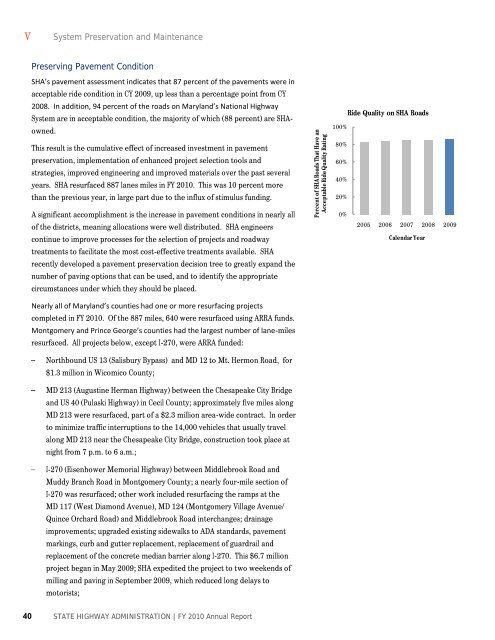2010 Annual Report - Maryland State Highway Administration
2010 Annual Report - Maryland State Highway Administration
2010 Annual Report - Maryland State Highway Administration
Create successful ePaper yourself
Turn your PDF publications into a flip-book with our unique Google optimized e-Paper software.
Percent of SHA Roads That Have an<br />
Acceptable Ride Quality Rating<br />
V<br />
System Preservation and Maintenance<br />
Preserving Pavement Condition<br />
SHA’s pavement assessment indicates that 87 percent of the pavements were in<br />
acceptable ride condition in CY 2009, up less than a percentage point from CY<br />
2008. In addition, 94 percent of the roads on <strong>Maryland</strong>’s National <strong>Highway</strong><br />
System are in acceptable condition, the majority of which (88 percent) are SHAowned.<br />
100%<br />
Ride Quality on SHA Roads<br />
This result is the cumulative effect of increased investment in pavement<br />
preservation, implementation of enhanced project selection tools and<br />
strategies, improved engineering and improved materials over the past several<br />
years. SHA resurfaced 887 lanes miles in FY <strong>2010</strong>. This was 10 percent more<br />
than the previous year, in large part due to the influx of stimulus funding.<br />
A significant accomplishment is the increase in pavement conditions in nearly all<br />
of the districts, meaning allocations were well distributed. SHA engineers<br />
continue to improve processes for the selection of projects and roadway<br />
treatments to facilitate the most cost-effective treatments available. SHA<br />
recently developed a pavement preservation decision tree to greatly expand the<br />
number of paving options that can be used, and to identify the appropriate<br />
circumstances under which they should be placed.<br />
Nearly all of <strong>Maryland</strong>’s counties had one or more resurfacing projects<br />
completed in FY <strong>2010</strong>. Of the 887 miles, 640 were resurfaced using ARRA funds.<br />
Montgomery and Prince George’s counties had the largest number of lane-miles<br />
resurfaced. All projects below, except I-270, were ARRA funded:<br />
Northbound US 13 (Salisbury Bypass) and MD 12 to Mt. Hermon Road, for<br />
$1.3 million in Wicomico County;<br />
MD 213 (Augustine Herman <strong>Highway</strong>) between the Chesapeake City Bridge<br />
and US 40 (Pulaski <strong>Highway</strong>) in Cecil County; approximately five miles along<br />
MD 213 were resurfaced, part of a $2.3 million area-wide contract. In order<br />
to minimize traffic interruptions to the 14,000 vehicles that usually travel<br />
along MD 213 near the Chesapeake City Bridge, construction took place at<br />
night from 7 p.m. to 6 a.m.;<br />
I-270 (Eisenhower Memorial <strong>Highway</strong>) between Middlebrook Road and<br />
Muddy Branch Road in Montgomery County; a nearly four-mile section of<br />
I-270 was resurfaced; other work included resurfacing the ramps at the<br />
MD 117 (West Diamond Avenue), MD 124 (Montgomery Village Avenue/<br />
Quince Orchard Road) and Middlebrook Road interchanges; drainage<br />
improvements; upgraded existing sidewalks to ADA standards, pavement<br />
markings, curb and gutter replacement, replacement of guardrail and<br />
replacement of the concrete median barrier along I-270. This $6.7 million<br />
project began in May 2009; SHA expedited the project to two weekends of<br />
milling and paving in September 2009, which reduced long delays to<br />
motorists;<br />
80%<br />
60%<br />
40%<br />
20%<br />
0%<br />
2005 2006 2007 2008 2009<br />
Calendar Year<br />
40<br />
STATE HIGHWAY ADMINISTRATION | FY <strong>2010</strong> <strong>Annual</strong> <strong>Report</strong>
















